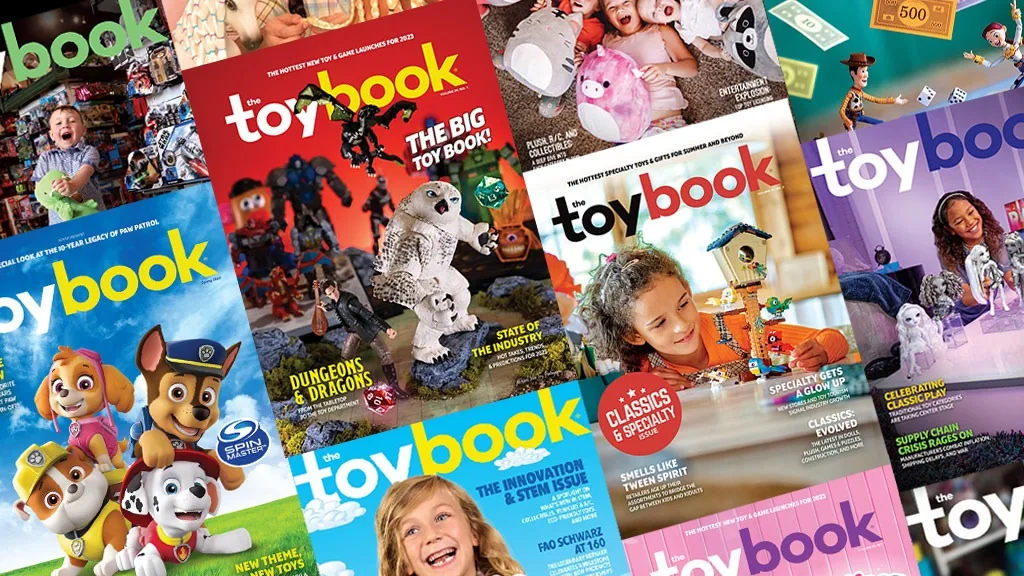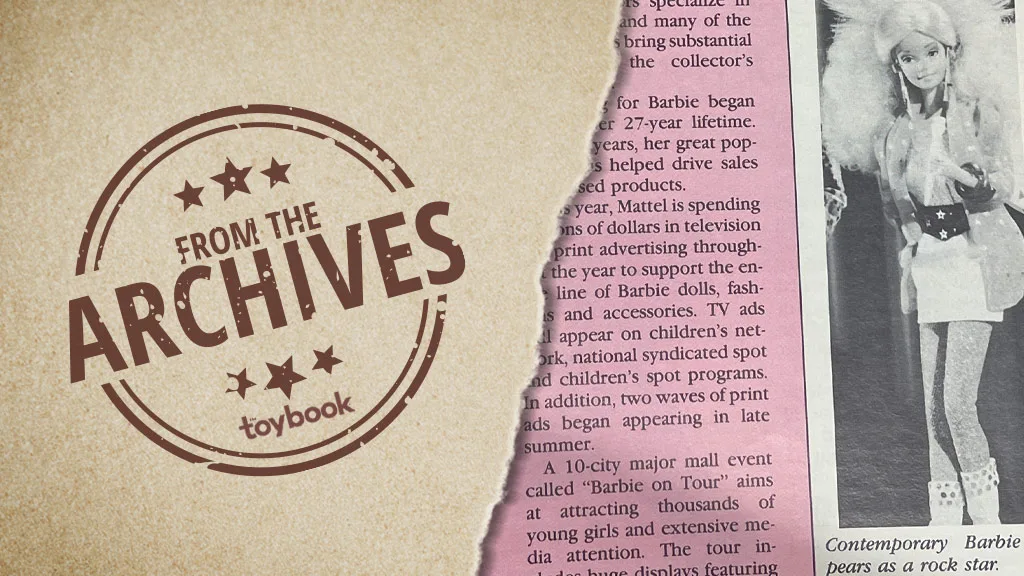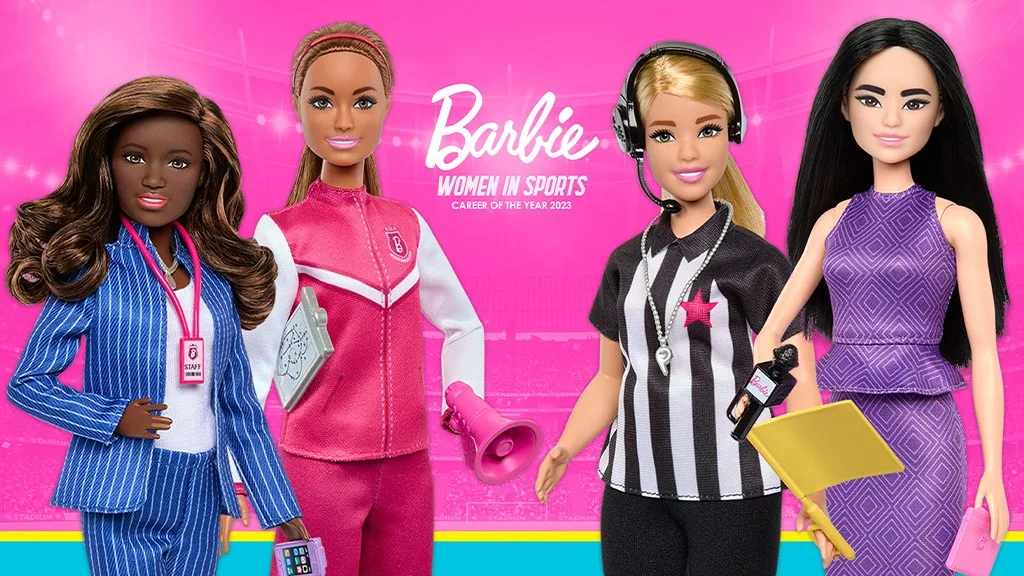Originally published in The Toy Book’s Character Licensing, September 1986. Some content may not match modern editorial style, standards, or formatting.
Barbie, an 11-1/2-inch plastic doll which has been marketed with astounding success by Mattel Toys for 27 years, has become a merchandising legend.
Backed by massive promotional support from Mattel, Barbie has chalked up unsurpassed sales and spawned a worldwide licensing program.
More than 300 million Barbie family dolls have been sold worldwide since the original Barbie was introduced in 1959. In addition, Mattel annually produces 20 pieces of Barbie doll’s fashions.
There are presently 300 Barbie licensees throughout the world, including 30 in the United States. The famous Barbie trademark is being used on items such as children’s jewelry, apparel, coloring books, stationery, toiletries, radios, and toothbrushes.
Barbie licensing benefits each year from Mattel’s new marketing programs and promotional efforts. The recently introduced “Barbie and the Rockers” theme has initiated a new stage in Barbie licensing. Basic Barbie licensees have added “Rockers” product, and some new licenses have been issued for The Rockers only.
Mattel Licensing is also planning to launch a new line of sportswear and accessories for 1987 based on its Barbie advertising slogan for this year – “We girls can do anything.” The slogan indicates that girls can become anything they want to be, just like Barbie, who is depicted as a lawyer, a veterinarian, a rock star, and even an astronaut.
Mattel was a toy industry pioneer when it introduced Barbie to a somewhat skeptical marketplace 27 years ago. The company had studied the popularity of paper dolls with adult-like figures and decided to translate this play concept into a three-dimensional doll with a fashionable wardrobe.
In 1959, the Barbie doll debuted in a market that was primarily accustomed to larger baby dolls. At Toy Fair, toy buyers were not particularly enthusiastic. But Barbie was introduced into retail stores, and by Christmas proved to be a big favorite with girls.
Over the succeeding years, Barbie’s world became more diverse. Ken was introduced as Barbie’s boyfriend and escort in 1961 and then became a personality in his own right.
In 1963, Mattel presented the first significant variation on the original Barbie doll, “Fashion Queen Barbie,” who had a sculptured hairstyle adaptable to various wigs. A year later, a technological breakthrough made it possible for Mattel to produce a Barbie doll whose knees could bend and eyes open and close.
A “Color Magic” version of introduced in Barbie was 1966, that allowed her costume and/or hair to change color with the application of a special solution. Barbie had a “Twist ‘N Turn” waist in 1967 and actually had a voice a year later.
She celebrated her “Sweet 16th” birthday in 1974; was given more action movement in 1975; and became a ballerina the following year. In 1977, Barbie was given a new face, with a bright smile and soft complexion, longer and thicker “sun-streaked” hair, and slender, moveable arms. She also received a new name, SuperStar Barbie.
Special versions of Barbie appeared to mark her 20th, 21st, and 25th birthdays. In addition, an international collection of Barbie dolls was created.
Over the years, Barbie’s world has constantly expanded with a growing circle of relatives, friends, and animal pets. They have included Midge, her best friend; her sister Skipper; Skooter and Ricky; Francie, Barbie’s cousin; Tutti and Todd, her twin sister and brother; Casey and Chris; Stacey and Christie; and many others. Her pets have included a variety of horses, an Afghan dog, and a kitten.
Today, a second generation of youngsters is playing with Barbie, just as their mothers did in the 1950s and ’60s. In addition, more than 3,000 adult collectors specialize in Barbie dolls, and many of the early versions bring substantial amounts to the collector’s marketplace.
Licensing for Barbie began early in her 27-year lifetime. Over the years, her great popularity has helped drive sales of licensed products.
This year, Mattel is spending millions of dollars in television and print advertising throughout the year to support the entire line of Barbie dolls, fashions, and accessories. TV ads will appear on children’s networks, nationally syndicated spots, and children’s spot programs. In addition, two waves of print ads began appearing in late summer.
A 10-city major mall event called “Barbie on Tour” aims at attracting thousands of young girls and extensive media attention. The tour includes huge displays featuring Barbie in a variety of imaginative and interactive environments. She is shown as an astronaut, in her fashionable new bedroom and in The Rockers Disco with a dancing environment.
Accompanying these displays is the “Billy Boy” collection of 700 Barbie dolls presented in a historical perspective.
Costumed Barbies are scheduled to make personal appearances at selected malls and department stores, giving away the “Barbie and The Rockers” record.
Barbie also receives exposure through the Barbie magazine, a publication that is distributed quarterly by subscription and at newsstands. In the magazine, with a circulation of 600,000, she gives tips on fashion and beauty. The magazine also includes activities, games, and puzzles.
The Barbie doll was included in the sealed Bicentennial time capsule in 1976, which is to be opened during the Tricentennial year of 2076. It was designated as the favorite doll of this century. There is little dispute about this designation.
Circle Reader Service No. 10

The Toy Book is even better in print. Click here to subscribe and receive six big issues of the toy industry’s leading trade publication, delivered directly to your mailbox! The Toy Book is North America’s longest-running print toy industry publication — on the #pulseofplay since 1984 and just getting started. Subscribe today!



